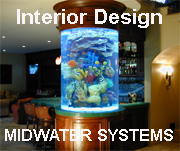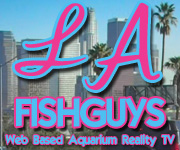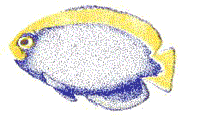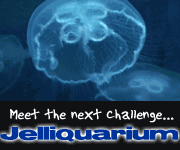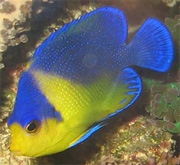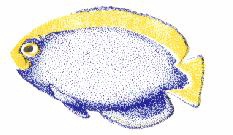|
Reef Filtration Methods
Depending on who you talk to, and how many people
you talk to, there are quite a few methods, and just as many opinions,
for setting up a coral reef tank. Keep this in mind...the essential componets
are; lighting, live rock, water flow and some form of filtration.
Within this article I will describe the basic
and various methods used for a reef tank filtration. Which method is for
you all depends on; how much you want to be involved, how much room you
have for equipment ( or lack of ), how much money you wish to spend, the
overall 'biodiversity' of life within the tank, and to what degree you
are striving for in an attempt to replicate a true reef enviroment. If
you are not familiar with basic Reef Tank filtration the review the Wet-Dry
Filter Page by clicking here
For reference sake the drawing below is representative
of a basic reef tank. The filtration incorporates a wet-dry trickle filter,
protien skimmer, and an external pump. The aquarium utilizes an internal
overflow and has gravel placed on its bottom with live rock stacked on
top of the gravel.
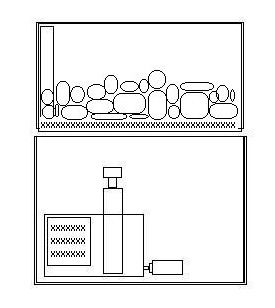
The Standard
method.
Water exits the tank via an overflow system at the
the top of the tank. It then passes through a pre-filter pad that traps
out the large particles of debri and is plumbed downwards to the wet-dry
filter.
The standard wet-dry filter utilizes bio-media,
such as bio-balls, within the filter. The idea of the bio-balls is they
offer a tremendous amount surface area for bacterias to adhere to,
as well as, allow air ( oxygen ) down into the media. The increased amount
of oxygen being exposed to, in combination with the thin sheets of organic
laden water passing over, the bacterias allows for a far more effective
bacteria. Keep in mind that is the amount of oxygen that allows the bacteria
to oxidize waste. The wet-dry filter is extremely effective in converting
ammonias ( NH4 ) and ntitrites ( NO2 ) into the lesser toxic form of nitrate
( NO3 ).
Aiding the filtration process is a protien skimmer
or foam fractionator. Essentially a protien skimmer helps remove compounds
from the water using heavy aeration to drive organics out of the water
thus lessening what the bacterias need to deal with.
Within the tank, at the bottom, is a layer of
sand or gravel approximately 1" deep. This represents the ocean floor.
Placed upon the sand bottom is the live rock. The live rock forms the foundation
that the living corals are placed upon.
The Berlin
method
Supposedly based upon reef tank filtration used
in Germany, this method decreases the effectiveness of biological filtration
by relying solely on the bacterial populations contained on and within
the live rock. There is no pre-filter pad within the overflow system and
all the bio-balls in the wet-dry filter are removed. The wet-dry filter
simply becomes the 'sump' or reservoir below the aquarium.
The thinking is that the prefilter pad and the
wet-dry filter are too efficient. The pre-filter pad eventually becomes
biologically active as it traps its debris and ultimately aids in converting
wastes. The bio-balls, in combination with the increased exposure to air
( oxygen ) too effectively convert ammonias ( NH4 ) and ntitrites ( NO2
) into the lesser toxic form of nitrate ( NO3 ). Both the pad and the bio-balls
ultimately produce Nitrate, which in standard method leads to quicker and
higher levels.
A greater emphasis is placed on the protien skimmer.
Since the protien skimmer helps remove compounds from the water it lessens
what the bacterias on the live rock need to deal with.
Within the tank, at the bottom, is NO sand or
gravel. A bare-bottom tank harbors less biological activity, and is much
easier to remove the debris that will settle there. Again a decrease in
biological filtration produces a slower developement of Nitrate. The live
rock, the foundation that the living corals are placed upon, is placed
directly on the bottom of the tank.
The live rock by itself contains a tremenous amount
of bacterias, and due to the lower amount of oxygen available to them they
do NOT convert wastes as effectively. The end result is a very capable
filter system, and one that does not generate Nitrates as quickly.
NOTE ; partially in lue of the sand at the
bottom of the tank, which helps produce calcium, the Berlin method uses
heavy amounts of Kalkwasser ( calcerous water ) for evaporative replacement.
The Algae
Scrubber method
As opposed to a wet-dry filter Algal Turf Scrubbers grow ( turf ) algaes
on screens that are in a seperate, but connected, system located outside
or below the main aquarium. The basic concept is that the algaes remove
nutrients from the water as their food source.
These screens should be scraped every 4-7 days as the algaes grow most
rapidly when they are short. Harvesting the algaes regularly during their
peak growth phase allows the nutrients, which are drawn up inside the algae,
to be removed from the entire system.
The flow of the water across the screen(s) comes from the main tank
and is returned to the tank That flow should be regulated, and if possible,
alternated not just run from one end of the system to the other. This can
be accomplished by a tilt tray or a dump bucket that creates a surge across
the trays. The surge idea is to give the algae time to exchange gasses
and absorb nutrients as well as provide light to all sides of the algae
for maximum growth in a small area.
For these algaes to grow they need light. The lighting of an algae scrubber
should be run the opposite to when the main tank lights are on. The reason
for using a light cycle opposite from the main tank is to maintain stable
pH, oxygen and carbon dioxide levels within in the system due to photosynthetic
respiration. This prevents the wide range fluctuations found in most tanks.
The type and output of the lighting will also affect the type of algae
and growth rates. Nearly any type of intense light can be used, metal halide,
VHO and HO flourescents, mercury vapor, halogen to name a few.
Within the tank, at the bottom, is a layer of
sand or gravel approximately 1" deep. Placed upon the sand bottom is the
live rock. The live rock forms the foundation that the living corals are
placed upon.
The Jaubert
method
The Jaubert method does NOT use an overflow nor does it have a reservior
below the aquarium. Dr. Jaubert, of the Monaco Aquarium, promotes a variation
of the Lee Chin Eng system which uses the 'natural' approach. The main
variation is the introduction of a Plenum at the bottom of the tank.
A plenum is a gap or void space underneath the one to four inches of
live sand at the bottom of the tank. Typically this void space is 1 inch
deep and this area becomes anoxic, or an area low in oxygen. This anoxic
area creates a 'ying-yang' enviroment where oxygen strarved organisms breakdown
or remove components from the oxygen carrying organisms and components.
The natural reduction of Nitrate ( NO3 ) in these systems is the direct
result of a plenum as it generates a 'de-nitrification' process that robs
the nitrate complex of its oxygen. Another benifit of the two opposing
enviroments is the natural dissolution of calcium, magnesium, and strontium
to natural levels within the aquarium.
The Jaubert system does not use a protien skimmer as the removal of
organics via skimmer would decrease the effectiveness of the plenum. Additionally
the only water movement within the tank is that of an airstone and its
resulting rising bubbles.
Placed upon the sand bottom is the live rock.
The live rock should be strategically positioned so that minimizes the
amount of sand that it actually covers, as the covered spots would quickly
cause dead areas within the sand that it sits upon.
The Live
Sand Bed method
In a reef tank with a live sand bed ( set up properly ) the hobbyist
is creating an enviroment that is more 'ecologically complete' or dynamic,
certainly more like a true reef enviroment. As debri from the tank settle
at the bottom of the tank there are a number of animals that feed on that
debri, lets call them detrivores ( animals whose food source is the debri
of other animals). These animals consist of crabs, shrimps, snails, starfish,
sea cucumbers, and bottom-dwelling fish. Whether or not these animals actually
consume or simply break up the debri into smaller particles, they are making
that debri even smaller and easier for the next level of organisms to break
it down further, physically and chemically.
The next level of 'micro-fauna' are the worms, bugs, and micro-scopic
forms of life. These creatures help to break down the debri even further,
but their greatest benifit is keeping the sand loose, or moving, and this
allows oxygenated water to penetrate the sand bed. If one were to place
a non-living bed of sand in a tank eventually it would become oxygen depleted.
The results of this no-oxygen ( called anoxic or anaerobic, meaning low
or without oxygen ) enviroment would be hyrodrogen sulfate ( that rotten
egg smell ), and the bed would eventually 'clump' together and become solid.
The worms, bugs, and micro-scopic life within the sand keep it loosely
suspended which allows oxygen down into the sand thus assisting the aerobic
( meaning with oxygen ) bacteria in being able to continue to chemically
convert the debri, biologically speaking.
There are many proponents of live sand beds. Their general consensis
is that this bed of sand should be three to four inches deep, at the least.
Some actually promote sand beds as deep as ten to twelve inches.
Placed upon the sand bottom is the live rock.
The live rock forms the foundation that the living corals are placed upon.
The
overall benifit of live sand beds is a more complete 'ecologically' balanced
system. Additionally, the processes of these small forms of life keeping
the sand bed moving, is the breaking down of the substrate itself, thus
various trace elements and calcium are released naturally back into the
water.
The Mud
/ Eco method
If one were to take the basic concepts of all the methods above you
would have the Mud System.
Envision removing all the bio-media from the sump below, place a layer
of 'mud' across its bottom, illuminate this chamber with light and grow
various algaes within it, you would have the Mud System. Granted that is
the simplified version, so let me explain.
The layer of 'mud' becomes a low oxygen enviroment allowing various
anoxic bacteria's to perform de-nitrification. The algaes harbor many small
creatures who help break down the debris, and in combination with the debris
this enviroment creates a fertile area for the plants to grow. The plants,
via photosythesis, consume a large percentage of the nirtogen rich debris.
The illumination, which is the opposite time frame of the main tank, provide
the energy for the plants, as well as, minimize the pH and carbon dioxide
fluctuations within the aquarium.
Within the tank, at the bottom, is a layer of
sand. Placed upon the sand bottom is the live rock. The live rock forms
the foundation that the living corals are placed upon.
|

